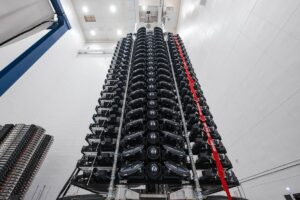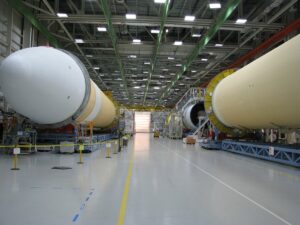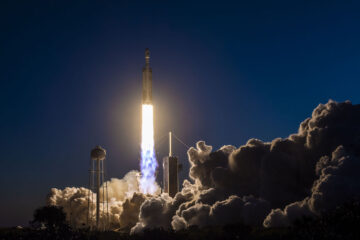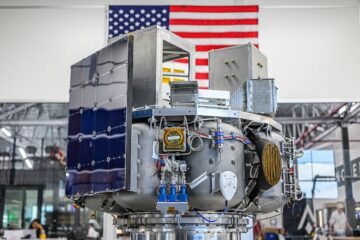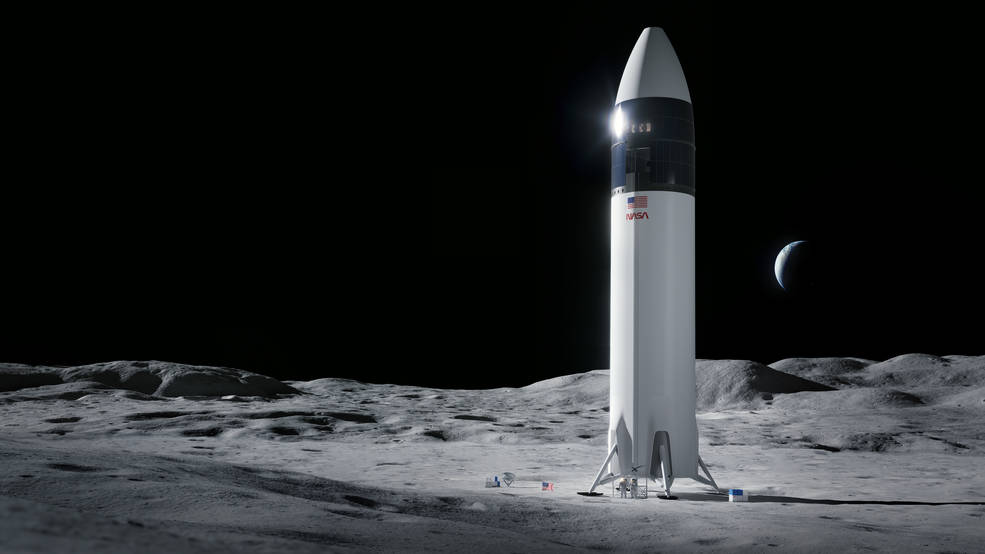
A senior NASA official raised concerns Wednesday that “difficulties” with SpaceX’s development of the huge new Starship rocket could delay the Artemis program’s first moon landing with astronauts from late 2025, a mission that will use a derivative of the Starship vehicle to ferry a two-person crew to and from the lunar surface.
Jim Free, head of NASA’s exploration systems development mission directorate, said SpaceX has much work to do before the Starship is cleared to land astronauts on the moon. NASA’s current schedule puts the Artemis program’s first astronaut landing on the moon, on the Artemis 3 mission, in late 2025.
“For Artemis 3, I mentioned that December ’25 is our current manifest date,” Free said Wednesday in a meeting of the National Academies’ Aeronautics and Space Engineering Board. “But with the difficulties that SpaceX has had, I think that’s really concerning. So you can think about that slipping probably into ’26.”
Before the Starship can fly to the moon, SpaceX needs to successfully launch the spacecraft into orbit. SpaceX’s first integrated test flight of the Starship, on top of its 33-engine Super Heavy booster, took off from the company’s Starbase facility in South Texas on April 20. SpaceX declared the test flight a success, with the Super Heavy booster and Starship clearing the launch pad and arcing over the Gulf of Mexico, beaming valuable data on its performance back to the ground for analysis by engineers.
The rocket then spun out of control after multiple engine failures, but a self-destruct system finally engaged to blow up the vehicle.
SpaceX ground teams are repairing damage to the launch pad in Texas and beefing up ground infrastructure before attempting a second Super Heavy/Starship test launch. Elon Musk, SpaceX’s founder and CEO, has suggested the launch site could be ready for another test flight by late summer.
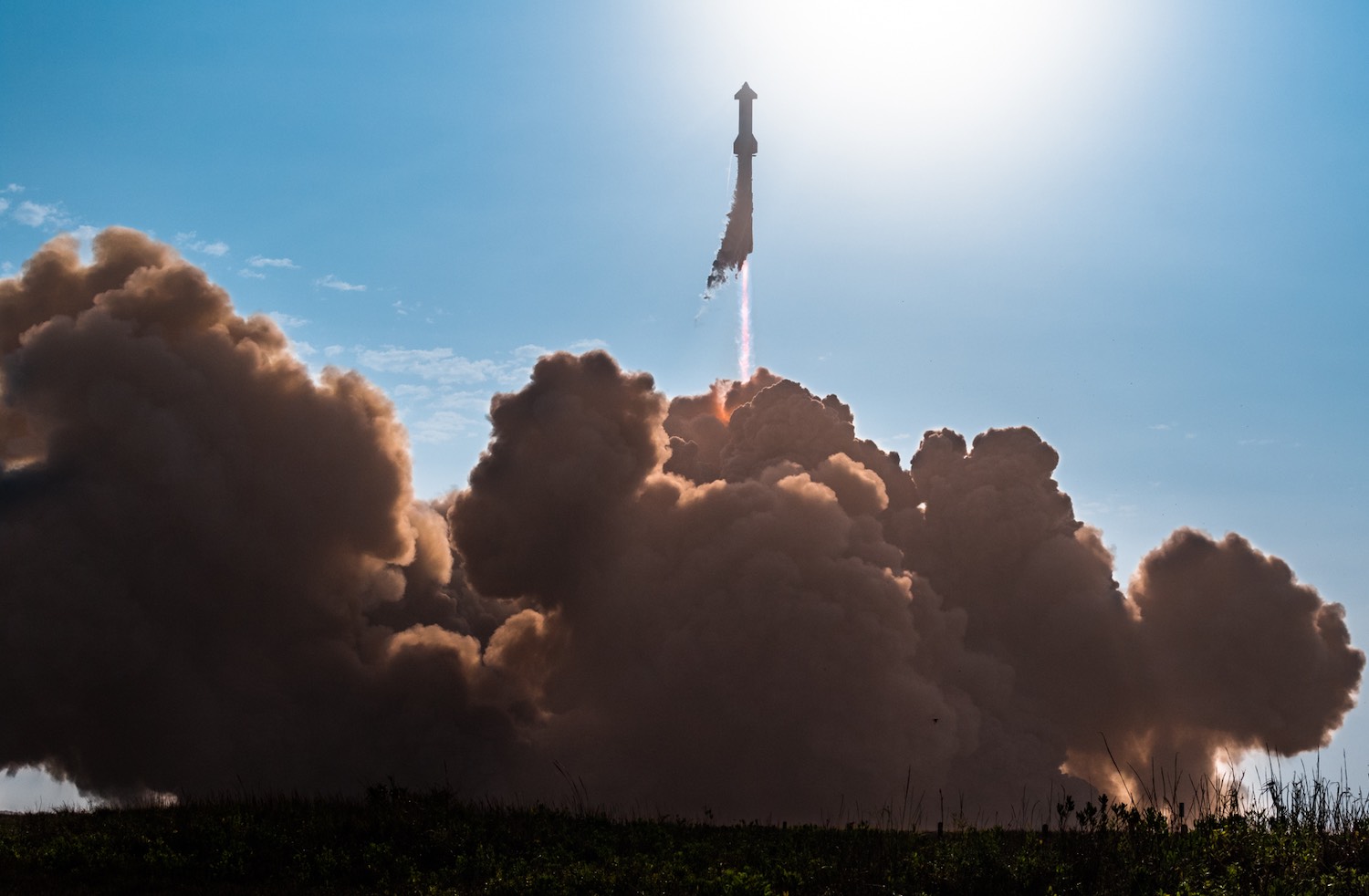
The Starship moon lander is not the only element of NASA’s Artemis architecture that may cause a delay in the Artemis 3 moon landing. NASA selected Axiom Space last year to develop a new spacesuit to protect astronauts walking on the moon, beginning with the Artemis 3 mission. The new spacesuit is more flexible than NASA’s existing decades-old bulky spacesuit design used for spacewalks at the International Space Station, making it better suited for walking in the reduced gravity environment at the moon.
NASA’s inspector general has identified the SpaceX Starship lander and the new spacesuits, both of which are being developed under commercial fixed-price contracts, as areas that could push back the Artemis 3 moon landing mission. The commercial procurement regime reduces the cost to NASA for development of the lander and spacesuits.
Free’s comments Wednesday focused on the progress of SpaceX’s Starship development, and were the first statements by a senior NASA official that the SpaceX moon lander could lead to a delay in the first Artemis moon landing.
“We have a firm fixed price contract with SpaceX, their job is to deliver that to us,” Free said. “And I’m going to hold them accountable to it. So I get a lot of questions, will you make the date? Well, they need to get flying before we can get any kind of assessment.”
NASA awarded a $2.9 billion contract to SpaceX in 2021 to provide a Starship vehicle as the Human Landing System for the Artemis 3 mission, which aims to become the first crew landing on the moon since 1972. The SpaceX proposal for the Human Landing System was the least expensive bid in the 2021 procurement, and has more cargo capacity than other bidders. Since then, NASA inked a contract with SpaceX for a second Starship lander for the Artemis 4 mission, and awarded a contract to Blue Origin for a human-rated lander for Artemis 5.
Under NASA’s current planning, the four-person crew on the Artemis 3 mission will lift off from NASA’s Kennedy Space Center on the agency’s Space Launch System moon rocket and Orion spacecraft, which were successfully test-flown around the moon last year on the unpiloted Artemis 1 mission. A second test flight of the SLS/Orion is scheduled for late 2024 on the Artemis 2 mission, which will send a crew of four around the far side of the moon before returning to Earth.
On Artemis 3, the Orion capsule will carry the astronauts to the vicinity of the moon, where SpaceX’s human-rated Starship lander will be waiting.
The 15-story-tall Starship lander will take off on top of SpaceX’s new Super Heavy booster, an enormous rocket SpaceX is designing to be recoverable and reusable. After reaching low Earth orbit a few hundred miles above the planet, the Starship will be refilled with methane and liquid oxygen propellants using a series of Starship tanker vehicles. SpaceX’s Starship design will have multiple iterations, with tankers, propellant depots, moon landers, and satellite launch vehicles, and deep space crew transporters.
In lunar orbit, the Orion spacecraft will dock with the Starship lander, and two of the astronauts will float into the Starship to descend to a landing site near the moon’s south pole. Two astronauts will remain aboard the Orion capsule in lunar orbit.
After several days on the surface, including multiple spacewalks, the Starship will launch back into space and rendezvous with the Orion spacecraft to reunite the four-person crew, then Orion will return the astronauts to Earth.

SpaceX and NASA have not disclosed an exact number of tanker launches required to support a single Starship flight to the moon. The company’s contract with NASA also covers an unpiloted Starship demo landing on the moon before the Artemis 3 mission.
“If you figure they need a number of launches to do their depot for our crewed flight, they need a number of launches to do the demo, they need a number of launches just to get flying, they have a significant number of launches to go,” Free said. “And that, of course, gives me concern about the December of 2025 date.”
Free said a major milestone before Starship’s unpiloted demonstration landing on the moon is a test of SpaceX’s ship-to-ship cryogenic propellant transfer system, a key technology required for any mission to send Starship beyond low Earth orbit. According to Free, NASA and SpaceX have delayed the critical design review for the Starship moon lander until SpaceX completes the ship-to-ship propellant transfer test.
The methane and liquid oxygen propellants used by the Raptor engines on the Starship vehicle are stored at super-cold temperatures. Without insulation, the propellants would gradually boil off when exposed to heating from the sun, adding a layer of complexity to refilling and storing the fuel and oxidizer in orbit. The methane and liquid oxygen propellant mix provides better efficiency than the room temperature but toxic hydrazine and nitrogen tetroxide propellants used on NASA’s Apollo lunar lander.
Methane and liquid oxygen could eventually be generated from resources on the moon or Mars, another benefit in switching from hydrazine and nitrogen tetroxide.
Free said NASA met with the Federal Aviation Administration recently to discuss the importance of the Starship rocket to the space agency’s moon exploration plans. The FAA is overseeing SpaceX’s investigation into the problems encountered on the April 20 test launch, when the flight termination system took longer to destroy the rocket than expected. The destruct system is designed to terminate the flight before an errant rocket threatens populated areas.
The FAA is not expected to grant SpaceX another Starship launch license until the investigation is complete, and federal regulators are satisfied with changes to the rocket to address any public safety concerns.
“They just have to get flying,” Free said of SpaceX. “When you step back and you look at (it), that’s a lot of launches to get those missions done, so our FAA partners are critical to that.”
Free said SpaceX provided an updated Starship schedule to NASA last week. NASA officials are currently reviewing the plan. The fixed-price contract with SpaceX for the Human Landing System puts any additional costs associated with delays or design changes on the contractor, not on NASA.
“I do have a lot of concern about it, and my expectation is they’re going to deliver,” Free said. “It’s great that we have a firm fixed-price contract because these are not cost uppers to us. But the fact is, if they’re not flying on the time they said, it’s no good if we have a firm fixed-price contract, other than we’re not paying more, which is important.”

Launching the Artemis 3 mission in 2026 is likely to still be a challenge, according to NASA’s inspector general, which reported in 2021 that based on the average delay of major NASA spaceflight programs, the moon lander may not be ready for crew flights until 2028.
NASA’s Artemis 4 mission is scheduled for launch in September 2028, a schedule that is also at risk because of delays in building a new mobile launch tower at the Kennedy Space Center. Artemis 4 requires a new launch platform because it will debut a larger Boeing-built upper stage on the SLS moon rocket, a development that could also put pressure on the 2028 launch schedule.
The more powerful Space Launch System rocket will carry a crew of four into space on an Orion spacecraft, along with an international habitation module to be assembled with NASA’s planned Gateway space station in lunar orbit. The first two elements of the Gateway station will launch toward the moon separately, without a crew, on a SpaceX Falcon Heavy rocket.
NASA wants to launch Artemis missions on a cadence of one per year after 2028, but the agency and its contractors must reduce the cost of the SLS moon rocket and Orion spacecraft for that to be feasible.
The agency’s inspector general has reported the first four Artemis missions will come at a cost of $4.1 billion per flight, a figure primarily driven by the cost of the SLS moon rocket and the Orion spacecraft. All the parts of the SLS rocket are single-use, while the Orion spacecraft, made by Lockheed Martin, is planned to eventually be reused for multiple flights.
Email the author.
Follow Stephen Clark on Twitter: @StephenClark1.
- SEO Powered Content & PR Distribution. Get Amplified Today.
- EVM Finance. Unified Interface for Decentralized Finance. Access Here.
- Quantum Media Group. IR/PR Amplified. Access Here.
- PlatoAiStream. Web3 Data Intelligence. Knowledge Amplified. Access Here.
- Source: https://spaceflightnow.com/2023/06/07/nasa-concerned-spacexs-starship-schedule-could-delay-first-artemis-moon-landing/
- :has
- :is
- :not
- :where
- $UP
- 1
- 20
- 2021
- 2024
- 2025
- 2026
- 2028
- 9
- a
- About
- about IT
- above
- According
- accountable
- adding
- Additional
- address
- administration
- Aeronautics
- After
- agency
- aims
- All
- along
- also
- an
- analysis
- and
- Another
- any
- apollo
- April
- architecture
- ARE
- areas
- around
- Artemis
- AS
- assembled
- assessment
- associated
- astronaut
- At
- attempting
- author
- average
- aviation
- back
- based
- BE
- because
- become
- before
- Beginning
- being
- benefit
- Better
- Beyond
- bid
- Billion
- blow
- Blue
- board
- booster
- both
- Building
- but
- by
- Cadence
- CAN
- Can Get
- Capacity
- Cargo
- carry
- Cause
- Center
- ceo
- challenge
- Changes
- Clearing
- COM
- come
- comments
- commercial
- Company’s
- complete
- Completes
- complexity
- Concern
- concerned
- concerning
- Concerns
- contract
- Contractor
- contractors
- contracts
- control
- Cost
- Costs
- could
- course
- covers
- credit
- critical
- cryogenic
- Current
- Currently
- damage
- data
- Date
- Days
- debut
- December
- deep
- delay
- Delayed
- delays
- deliver
- Demo
- derivative
- descend
- Design
- designed
- designing
- destroy
- develop
- developed
- Development
- difficulties
- discuss
- do
- Dock
- document
- done
- driven
- during
- earth
- efficiency
- element
- elements
- Elon
- Elon Musk
- engaged
- Engine
- Engineering
- Engineers
- Engines
- enormous
- Environment
- eventually
- existing
- expectation
- expected
- expensive
- exploration
- exposed
- faa
- Facility
- fact
- falcon
- far
- feasible
- Federal
- Federal Aviation Administration
- federal regulators
- few
- Figure
- Finally
- Firm
- First
- fixed
- flexible
- flight
- Flights
- Float
- flying
- focused
- For
- founder
- Founder and CEO
- four
- Free
- from
- Fuel
- gateway
- General
- generated
- get
- gives
- Go
- going
- good
- gradually
- grant
- gravity
- great
- Ground
- had
- Have
- head
- heavy
- hold
- http
- HTTPS
- huge
- human
- hundred
- i
- identified
- if
- importance
- important
- in
- Including
- Infrastructure
- inked
- integrated
- integration
- International
- international space station
- into
- investigation
- IT
- iterations
- ITS
- Job
- jpg
- just
- Key
- Kind
- Land
- landing
- larger
- Last
- Last Year
- Late
- launch
- launches
- layer
- lead
- least
- License
- likely
- linked
- Liquid
- Lockheed Martin
- longer
- Look
- Lot
- Low
- Lunar
- lunar lander
- made
- major
- make
- Making
- mars
- Martin
- max-width
- May..
- meeting
- mentioned
- methane
- Mexico
- milestone
- Mission
- missions
- Mobile
- module
- Moon
- more
- much
- multiple
- Musk
- must
- my
- Nasa
- National
- Near
- Need
- needs
- New
- no
- number
- of
- off
- official
- officials
- on
- ONE
- only
- or
- Orbit
- Other
- our
- out
- over
- overseeing
- Oxygen
- pad
- partners
- parts
- paying
- performance
- plan
- planet
- planned
- planning
- plans
- platform
- plato
- Plato Data Intelligence
- PlatoData
- populated
- powerful
- pressure
- price
- primarily
- probably
- problems
- Programs
- Progress
- proposal
- protect
- provide
- provided
- provides
- public
- Push
- push back
- put
- Puts
- Questions
- raised
- reaching
- Readiness
- ready
- really
- recently
- reduce
- Reduced
- reduces
- regime
- Regulators
- remain
- repairing
- Reported
- required
- requires
- Resources
- return
- returning
- reusable
- review
- reviewing
- Risk
- rocket
- Room
- Safety
- Said
- satellite
- satisfied
- satisfied with
- schedule
- scheduled
- Second
- selected
- send
- senior
- September
- Series
- several
- side
- significant
- Signs
- since
- single
- site
- slipping
- So
- South
- Space
- space station
- spacecraft
- spaceflight
- SpaceX
- spun
- Stage
- starship
- statements
- station
- Step
- Stephen
- Still
- stored
- success
- Successfully
- summer
- Sun
- Super
- support
- Surface
- system
- Systems
- Take
- teams
- Technology
- test
- texas
- than
- that
- The
- their
- Them
- then
- These
- they
- think
- those
- threatens
- time
- to
- together
- took
- top
- toward
- Tower
- transfer
- Trevor
- two
- under
- until
- updated
- us
- use
- used
- using
- Valuable
- vehicle
- Vehicles
- Waiting
- walking
- wants
- was
- we
- Wednesday
- week
- WELL
- were
- when
- which
- while
- will
- with
- without
- Work
- would
- year
- you
- zephyrnet

